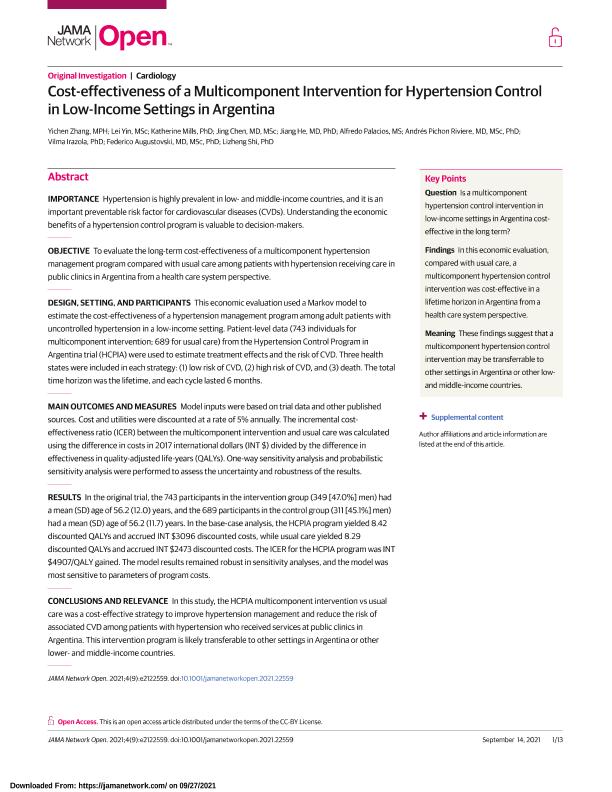Artículo
Cost-effectiveness of a Multicomponent Intervention for Hypertension Control in Low-Income Settings in Argentina
Zhang, Yichen; Yin, Lei; Mills, Katherine; Chen, Jing; He, Jiang; Palacios, Alfredo Daniel; Pichón-riviere, Andres ; Irazola, Vilma
; Irazola, Vilma ; Augustovski, Federico Ariel
; Augustovski, Federico Ariel ; Shi, Lizheng
; Shi, Lizheng
 ; Irazola, Vilma
; Irazola, Vilma ; Augustovski, Federico Ariel
; Augustovski, Federico Ariel ; Shi, Lizheng
; Shi, Lizheng
Fecha de publicación:
09/2021
Editorial:
American Medical Association
Revista:
JAMA Network Open
ISSN:
2574-3805
Idioma:
Inglés
Tipo de recurso:
Artículo publicado
Clasificación temática:
Resumen
Importance: Hypertension is highly prevalent in low- and middle-income countries, and it is an important preventable risk factor for cardiovascular diseases (CVDs). Understanding the economic benefits of a hypertension control program is valuable to decision-makers. Objective: To evaluate the long-term cost-effectiveness of a multicomponent hypertension management program compared with usual care among patients with hypertension receiving care in public clinics in Argentina from a health care system perspective. Design, Setting, and Participants: This economic evaluation used a Markov model to estimate the cost-effectiveness of a hypertension management program among adult patients with uncontrolled hypertension in a low-income setting. Patient-level data (743 individuals for multicomponent intervention; 689 for usual care) from the Hypertension Control Program in Argentina trial (HCPIA) were used to estimate treatment effects and the risk of CVD. Three health states were included in each strategy: (1) low risk of CVD, (2) high risk of CVD, and (3) death. The total time horizon was the lifetime, and each cycle lasted 6 months. Main Outcomes and Measures: Model inputs were based on trial data and other published sources. Cost and utilities were discounted at a rate of 5% annually. The incremental cost-effectiveness ratio (ICER) between the multicomponent intervention and usual care was calculated using the difference in costs in 2017 international dollars (INT $) divided by the difference in effectiveness in quality-adjusted life-years (QALYs). One-way sensitivity analysis and probabilistic sensitivity analysis were performed to assess the uncertainty and robustness of the results. Results: In the original trial, the 743 participants in the intervention group (349 [47.0%] men) had a mean (SD) age of 56.2 (12.0) years, and the 689 participants in the control group (311 [45.1%] men) had a mean (SD) age of 56.2 (11.7) years. In the base-case analysis, the HCPIA program yielded 8.42 discounted QALYs and accrued INT $3096 discounted costs, while usual care yielded 8.29 discounted QALYs and accrued INT $2473 discounted costs. The ICER for the HCPIA program was INT $4907/QALY gained. The model results remained robust in sensitivity analyses, and the model was most sensitive to parameters of program costs. Conclusions and Relevance: In this study, the HCPIA multicomponent intervention vs usual care was a cost-effective strategy to improve hypertension management and reduce the risk of associated CVD among patients with hypertension who received services at public clinics in Argentina. This intervention program is likely transferable to other settings in Argentina or other lower- and middle-income countries.
Palabras clave:
Cost-effectiveness
,
Hypertension Control
,
Low-Income Settings
,
Argentina
Archivos asociados
Licencia
Identificadores
Colecciones
Articulos(CIESP)
Articulos de CENTRO DE INVESTIGACIONES EN EPIDEMIOLOGIA Y SALUD PUBLICA
Articulos de CENTRO DE INVESTIGACIONES EN EPIDEMIOLOGIA Y SALUD PUBLICA
Citación
Zhang, Yichen; Yin, Lei; Mills, Katherine; Chen, Jing; He, Jiang; et al.; Cost-effectiveness of a Multicomponent Intervention for Hypertension Control in Low-Income Settings in Argentina; American Medical Association; JAMA Network Open; 9-2021; 1-13
Compartir
Altmétricas



